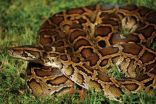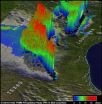(Press-News.org) Smithsonian scientists and their colleagues have uncovered a new threat posed by invasive Burmese pythons in Florida and the Everglades: The snakes are not only eating the area's birds, but also the birds' eggs straight from the nest. The results of this research add a new challenge to the area's already heavily taxed native wildlife. The team's findings are published in the online journal Reptiles & Amphibians: Conservation and Natural History.
Burmese pythons, native to southern Asia, have taken up a comfortable residence in the state of Florida, especially in the Everglades. In addition to out-competing native wildlife for resources and habitat, the pythons are eating the native wildlife. Burmese pythons (Python molurus bivittatus) were first recorded in the Everglades in 1979—thought to be escaped or discarded pets. Their numbers have since grown, with an estimated breeding population in Florida in the tens of thousands.
In an ongoing study to better understand the impact of this snake in the Everglades, scientists from the Smithsonian Institution, the National Park Service and others have been examining the contents of the digestive tracts of pythons in the area. They have shown that Burmese pythons consume at least 25 different species of birds in the Everglades, but until now no records documented this species eating bird eggs.
"This finding is significant because it suggests that the Burmese python is not simply a sit-and-wait predator, but rather is opportunistic enough to find the nests of birds," said Carla Dove, ornithologist at the Smithsonian's Feather Identification Lab in the National Museum of Natural History and lead author of the study. "Although the sample size is small, these findings suggest that the snakes have the potential to negatively affect the breeding success of native birds."
Scientists collected a 14-pound male python that was 8 ½ feet long near a property with free-ranging guineafowl. The snake regurgitated 10 whole guineafowl eggs soon after it was captured. The team discovered the remains of two bird eggs in another python collected for the study―a 30-pound female more than 10 feet long. Scientists used DNA tests on the membrane of the crushed eggs and comparisons of the shell fragments with egg specimens in the Smithsonian's collection to determine what the female snake had eaten. Their research revealed the species to be the limpkin (Aramus guarauna), a large wading bird found in marshes and listed as a "species of special concern" by the Florida Fish and Wildlife Conservation Commission.
There are several species of snake known to eat bird eggs. Those species are equipped with pointed or blade-like extensions on the vertebrae in their esophagus that punctures the eggshell, making it easy for the snake to crush the egg and digest its contents.
Burmese pythons do not have these adaptations. However, the pythons studied were so large in relation to the eggs they ingested that the scientists believe these specialized vertebrae may not have been needed.
"Our observations confirm that invasive Burmese pythons consume not only adult birds but also eggs, revealing a previously unrecognized risk from this introduced predator to nesting birds," said Dove. "How frequently they are predating on bird eggs is hard to know."
In an earlier stage of the study, the scientists collected more than 300 Burmese pythons in Everglades National Park and found that birds, from the 5-inch-long house wren to the 4-foot-long great blue heron, accounted for 25 percent of the python's diet in the Everglades.
INFORMATION:
Scientists discover new threat to birds posed by invasive pythons
2012-04-10
ELSE PRESS RELEASES FROM THIS DATE:
Study reveals impact of socioeconomic factors on the racial gap in life expectancy
2012-04-10
Differences in factors such as income, education and marital status could contribute overwhelmingly to the gap in life expectancy between blacks and whites in the United States, according to one of the first studies to put a number on how much of the divide can be attributed to disparities in socioeconomic characteristics.
A Princeton University study recently published in the journal Demography reveals that socioeconomic differences can account for 80 percent of the life-expectancy divide between black and white men, and for 70 percent of the imbalance between black ...
Researchers discover unique suspension technique for large-scale stem cell production
2012-04-10
Post-doctoral researcher David Fluri and Professor Peter Zandstra at the University of Toronto's Institute of Biomaterials and Biomedical Engineering (IBBME) have developed a unique new technique for growing stem cells that may make possible cost-effective, large-scale stem cell manufacturing and research.
Although stem cells are widely used for the testing of new drugs, researchers have always faced difficulties manufacturing enough viable cells from a culture. Typically, stem cells are grown on surfaces that must be scraped, and which must then be differentiated from ...
NASA's TRMM Satellite sees tornadic Texas storms in 3-D
2012-04-10
NASA's Tropical Rainfall Measuring Mission (TRMM) satellite provides a look at thunderstorms in three dimensions and shows scientists the heights of the thunderclouds and the rainfall rates coming from them, both of which indicate severity.
Powerful thunderstorms that created severe weather were more than 8 miles high.
NOAA's National Weather Service Storm Prediction Center received 18 reports of tornadoes occurring on April 3 over northeastern Texas. Some of these very destructive storms dropped softball sized hail as they passed to the south of the Dallas/Fort ...
Women cannot rewind the 'biological clock'
2012-04-10
Many women do not fully appreciate the consequences of delaying motherhood, and expect that assisted reproductive technologies can reverse their aged ovarian function, Yale researchers reported in a study published in a recent issue of Fertility and Sterility.
"There is an alarming misconception about fertility among women," said Pasquale Patrizio, M.D., professor in the Department of Obstetrics & Gynecology at Yale School of Medicine and director of the Yale Fertility Center. "We also found a lack of knowledge about steps women can take early in their reproductive ...
Salk scientists redraw the blueprint of the body's biological clock
2012-04-10
La Jolla, CA----The discovery of a major gear in the biological clock that tells the body when to sleep and metabolize food may lead to new drugs to treat sleep problems and metabolic disorders, including diabetes.
Scientists at the Salk Institute for Biological Studies, led by Ronald M. Evans, a professor in Salk's Gene Expression Laboratory, showed that two cellular switches found on the nucleus of mouse cells, known as REV-ERBα and REV-ERBβ, are essential for maintaining normal sleeping and eating cycles and for metabolism of nutrients from food.
The findings, ...
Which plants will survive droughts, climate change?
2012-04-10
New research by UCLA life scientists could lead to predictions of which plant species will escape extinction from climate change.
Droughts are worsening around the world, posing a great challenge to plants in all ecosystems, said Lawren Sack, a UCLA professor of ecology and evolutionary biology and senior author of the research. Scientists have debated for more than a century how to predict which species are most vulnerable.
Sack and two members of his laboratory have made a fundamental discovery that resolves this debate and allows for the prediction of how diverse ...
Long-term studies detect effects of disappearing snow and ice
2012-04-10
Ecosystems are changing worldwide as a result of shrinking sea ice, snow, and glaciers, especially in high-latitude regions where water is frozen for at least a month each year—the cryosphere. Scientists have already recorded how some larger animals, such as penguins and polar bears, are responding to loss of their habitat, but research is only now starting to uncover less-obvious effects of the shrinking cryosphere on organisms. An article in the April issue of BioScience describes some impacts that are being identified through studies that track the ecology of affected ...
Long-term research reveals causes and consequences of environmental change
2012-04-10
WASHINGTON, D.C., APRIL 6, 2012—As global temperatures rise, the most threatened ecosystems are those that depend on a season of snow and ice, scientists from the nation's Long Term Ecological Research (LTER) Network say."The vulnerability of cool, wet areas to climate change is striking," says Julia Jones, a lead author in a special issue of the journal BioScience released today featuring results from more than 30 years of LTER, a program of the National Science Foundation (NSF).
In semi-arid regions like the southwestern United States, mountain snowpacks are the dominant ...
Long-term neuropsychological impairment is common in acute lung injury survivors
2012-04-10
Cognitive and psychiatric impairments are common among long-term survivors of acute lung injury (ALI), and these impairments can be assessed using a telephone-based test battery, according to a new study.
"Neuropsychological impairment is increasingly being recognized as an important outcome among survivors of critical illness, but neuropsychological function in long-term ALI survivors has not been assessed in a multi-center trial, and evidence on the etiology of these impairments in ALI survivors is limited," said lead author Mark E. Mikkelsen, MD, MSCE, assistant professor ...
Scientists forecast forest carbon loss
2012-04-10
When most people look at a forest, they see walking trails, deer yards, or firewood for next winter. But scientists at the Harvard Forest and Smithsonian Institution take note of changes imperceptible to the naked eye -- the uptake and storage of carbon. What they've learned in a recent study is that an immense amount of carbon is stored in growing trees, but if current trends in Massachusetts continue, development would reduce that storage by 18 percent over the next half century. Forest harvesting would have a much smaller impact.
Jonathan Thompson is Research Ecologist ...




